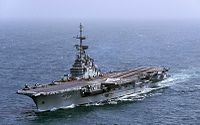
Photo from wikipedia
BACKGROUND In Brazil, schistosomiasis mansoni cases still occur, even in non-endemic areas. This study aimed to evaluate schistosomiasis mansoni cases and to delimit water collections investigated for infested planorbidae in… Click to show full abstract
BACKGROUND In Brazil, schistosomiasis mansoni cases still occur, even in non-endemic areas. This study aimed to evaluate schistosomiasis mansoni cases and to delimit water collections investigated for infested planorbidae in São Carlos, São Paulo, Brazil. METHODS A cross-sectional descriptive study and spatial analysis of schistosomiasis mansoni cases notified in the city from January 2005 to December 2017 was conducted. The study used geographical information system software to map residential and leisure exposures to water courses and bodies and related them to planorbidae surveys of São Paulo state. RESULTS During the study period, 32 cases were notified. The main forms were intestinal and hepatosplenic. Twenty-eight cases were allochthonous, two autochthonous and two indeterminate. Eleven patients (33.3%) had contact with water collections in São Carlos, mainly the 29 and Broa reservoirs. Three of them had contact only with water collections in the region. A third of cases lived in the Água Fria and Água Quente microbasins, highly impacted by the presence of domestic sewage, and the whole region seems to be colonized by Biomphalaria tenagophila. CONCLUSIONS The resolution of anthropogenic contamination of water bodies is crucial for controlling schistosomiasis mansoni autochthony in São Carlos.
Journal Title: Transactions of the Royal Society of Tropical Medicine and Hygiene
Year Published: 2022
Link to full text (if available)
Share on Social Media: Sign Up to like & get
recommendations!